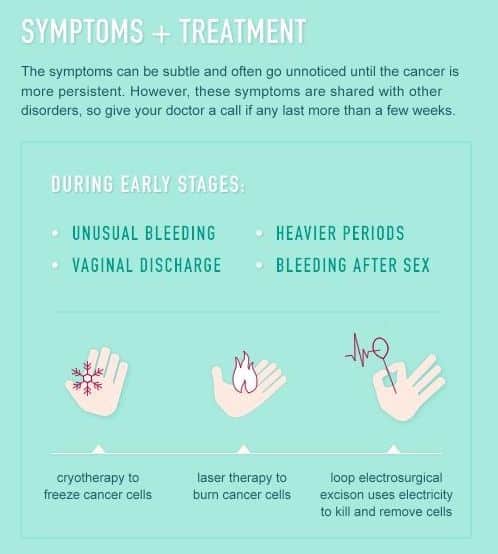Cervical Health Awareness: Types of Cervical Cancer and Reducing Your Risk
By: Tessa Gilliland
January is National Cervical Health Awareness Month, a month that brings awareness to what cervical cancer is, how to prevent it as well as how to detect it. It is a very preventable and treatable cancer because of current screenings and vaccines. Cervical cancer begins in the lining of the cervix, the lower part of the uterus. It is the most common cancer found in women, affecting more than 500,000 women every year (Healthy Women).
Types of Cervical Cancer
There are two types of cervical cancer. The most common cervical cancer, affecting nine out of ten women is squamous cell carcinoma. Squamous cell carcinoma starts in the thin, flat cells that line the outer part of the cervix. The other type of cervical cancer is adenocarcinoma. Adenocarcinoma develops in the column-shaped cells that line the cervical canal (Mayo Clinic).
Symptoms
Women with pre-cancer typically do not show any symptoms. Symptoms only appear when the cancer becomes more invasive and spreads to nearby parts of the body. Once the pre-cancer develops into cancer, the symptoms are noticeable. Symptoms include:
• Abnormal vaginal bleeding; bleeding after vaginal sex and after menopause, bleeding and spotting between periods, and having menstrual periods that are longer or heavier than usual.
• An unusual discharge from the vagina, which may contain blood and occur between periods or after menopause.
• Pain during sex.
These symptoms can be caused by other infections and do not mean it is cervical cancer. It is important that if any of these symptoms are being experienced to visit a healthcare professional as soon as possible. If the symptoms are ignored, the cause of the issue can worsen to a more advanced case, which is more difficult to treat (American Cancer Society).
Risk Factors
There are many risk factors that can increase the likelihood of developing cervical cancer. These include:
• Human Papillomavirus (HPV) infection
• Smoking
• Many sexual partners
• Having a weakened immune system
• Chlamydia infection
• A diet low in fruits and vegetables
• Being overweight
• Long term use of birth control pills
• Intrauterine device (IUD)
• Having multiple full-term pregnancies
• Being younger than 17 at your first full-term pregnancy
• Family history of cervical cancer
These are the most common risk factors for developing cervical cancer; however, it is hard to limit one factor as the main cause. Many women with these risks will not develop cervical cancer, but it is important to monitor the risk factors. It helps to minimize the risk factors that can be controlled to help decrease the chance of developing cervical cancer (American Cancer Society).
Causes
Cervical cancer is caused when healthy cells develop a mutation and turn into abnormal cells. Healthy cells grow and die at a set rate, and cancer cells multiply rapidly and do not die. The abnormal cells form a tumor and can eventually break off and invade other areas of the body (Mayo Clinic).

Female Reproductive System Diagram
Prevention
One way to stop cervical cancer from developing is to treat it while it is in the pre-cancer stage. Detecting the development of pre-cancer is another way of preventing cervical cancer, because pre-cancer is easier to treat. The best way to prevent pre-cancers is by getting the HPV vaccine, testing for HPV, not smoking and using condoms (Mayo Clinic).
A great way to prevent cervical cancer is to have screenings. The Pap test, or a Pap smear, and the HPV test, are tests that can detect pre-cancers. If pre-cancer shows up, it can be treated before the cervical cancer forms. A Pap test is a test where doctors collect cells from the cervix to be looked at under a microscope to find cancer and pre-cancer. The same cells that were pulled for the Pap test can be used for HPV testing as well (Mayo Clinic). Women over the age of 21 should start receiving screenings. Women aged 21-29 should receive Pap tests every three years.
HPV is a huge risk factor for developing cervical cancer. There are a few ways to prevent getting HPV. It is passed from person-to-person through skin contact with the infected area of the body. HPV can also be spread from one part of the body to another, for example it may start in the cervix and later spread to the vagina. One way of preventing HPV is by limiting the number of sex partners and avoiding sex with people who have had many other sex partners. HPV is very common. Having sexual activity with even one person can still be a risk. Since there are not any symptoms for HPV, someone can have it for years without knowing and pass it on (American Cancer Society).
Vaccines are a great way to prevent certain HPV infections, mainly the ones that typically lead to cancer. Vaccines serve as a great prevention tool, but they cannot treat a pre-existing condition. They typically require a series of shots with mild side effects. It is recommended for young women up to the age of 26 and young men through the age of 21. It’s also recommended for men who have sex with men, young adults who are transgender through the age of 26 and young adults with certain conditions that impact the immune system (including HIV) through 26.

Cervical Cancer
Treatment
Since there are many stages of cervical cancer, there are many different treatment options. It also depends on where the cancer is located in the cervix, the type of cancer cells, the age and health of the patient and whether or not they want children in their future.
The most common types of treatments for cervical cancer include surgery, radiation therapy, chemotherapy and immunotherapy. Surgery can be used to diagnose cervical cancer, determine how far the cancer has spread and can serve as a treatment option, typically for the earlier stages. Radiation therapy uses high powered x-rays to kill cancer cells. Radiation can be used as part of the main treatment stage, but sometimes it is used after surgery. Chemotherapy is another treatment option for those who were diagnosed with cervical cancer, as well as those who had cervical cancer and it came back after treatment. In some stages of cervical cancer, both chemotherapy and radiation are recommended. Immunotherapy is another option for cervical cancer. Immunotherapy is the use of medication that stimulates the immune system to recognize and destroy cancer effectively (American Cancer Society).
Cervical cancer can be hard to spot, but with screenings, it can be found and treated sooner. To schedule an appointment with a healthcare provider to get tested, please contact AxessPointe Community Health Centers, Inc. today. For a full list of medical services, visit: https://axesspointe.org/medical-services/ Call us at 330-564-8660 to schedule an appointment!
REFERENCES
“Cervical Cancer.” American Cancer Society, www.cancer.org/cancer/cervical-cancer
“Cervical Cancer.” Mayo Clinic, Mayo Foundation for Medical Education and Research, 23 Aug. 2017, www.mayoclinic.org/diseases-conditions/cervical-cancer/symptoms-causes/syc-20352501
“Get Screened: January Is Cervical Health Awareness Month.” HealthyWomen, www.healthywomen.org/content/article/get-screened-january-cervical-health-awareness-month
“HPV | Who Should Get Vaccine | Human Papillomavirus | CDC.” Centers for Disease Control and Prevention, Centers for Disease Control and Prevention, www.cdc.gov/hpv/parents/vaccine.html


